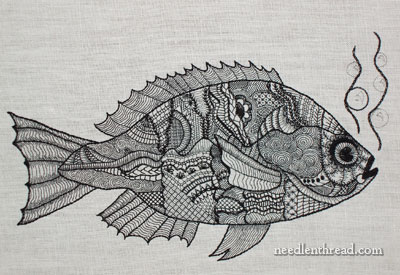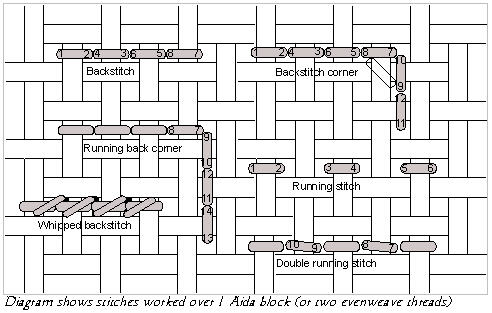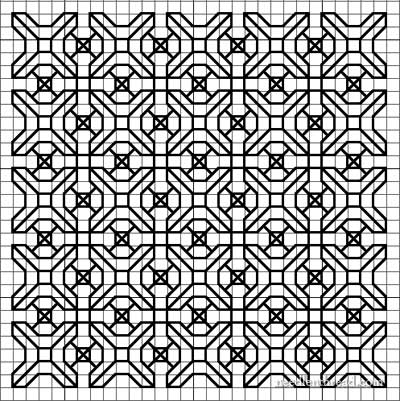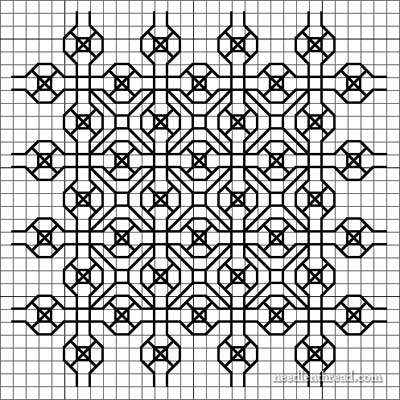I've seen a lot of different needlepoint canvases of people. There are some simple portraits, and then there are some very detailed portraits. Certainly doing people in needlepoint would be time consuming, but I think the results are worth the time. They are beautiful canvases.
One of the type of needlepoint portrait that I've seen is a reproduction of a master pa

inting. There are definitely a lot of canvases available of paintings from artists like Vermeer, Picasso,
Matisse, Degas, and Renoir. The work in progress on the right by
Robyne Melia looks like it's being copied from a Ingres painting. What's amazing about this person is that they are free-stitching it. She didn't draw in the different colors and where they were going to place them. She is deciding as she goes. It looks like it's going to be very impressive! I'm definitely
already impressed, and it's only about 1/3 of the way finished!
The painting below is a painted canvas by Barbara Russell. We love it! Not only is the portrait fabulous, but with all of the fun colors and shapes, you really

could do a lot of different fun stitches and practice using fun fibers as well!
Another technique of using needlepoint for a portrait can be seen in the following canvas. The artist, Megan Morman, uses saturated colors and a pop art kind of feel to paint her subjects. The colors are not usually naturalistic. A lot of her pieces look like snapshots that had the colors modified. I like how detailed she got in her pieces, yet they still keep a very individualistic aspect. The way she has shaded them looks painterly. Like I have mentioned in other posts, needlepoint and needle arts have been around forev

er, but they are still respected and often used as art forms in contemporary art shown in galleries. Ms. Morman's work has been shown in galleries. You can view it and other pictures of hers on her
Flickr page.
There are a lot of artists that people find inspiring. It seems almost natural to want to have a piece of your favorite artist's work on your wall. However, you may not be able to afford to buy an original, or even a print, or maybe you just want to make one of their images your own. The artist below, MeroSmero, really liked the art of Piero Fornasetti and decided to do a needlepoint of one of his images. I like that she took an image that was inspired by a classical portrait, that had then been modified and made humorous,

and made it her own by translating it into needlepoint, which is a traditonal art form, much like the painting had originally been. It's kind of funny when you think how art is inpsired by traditional art forms as well as contemporary. If you'd like to see other work she has done, you can visit her page on
Flickr.
If you would like to try a portrait for your next project, we certainly have many canvases ready made that have people as their subjects. However Jim, our custom painter, can take one of your photos and make a custom piece just for you! The photo on the right is his version of the famous Obam

a poster. Whether you want something graphic or something very naturalistic and detailed, he would be able to help you.
Portraits are very personal and can really help show someone's true self. Doing a needlepoint portrait would be a great way to personalize a portrait and make it unique.
 Continental stitch, which is stitched on a horizontal row, Basketweave is stitched diagonally. Check out the diagram on the right, which shows exactly how to stitch in Basketweave.
Continental stitch, which is stitched on a horizontal row, Basketweave is stitched diagonally. Check out the diagram on the right, which shows exactly how to stitch in Basketweave. tweave distorts the canvas less than other stitches. This is another plus to using this key stitch. The picture to the left shows what the stitches look like when they are stitched.
tweave distorts the canvas less than other stitches. This is another plus to using this key stitch. The picture to the left shows what the stitches look like when they are stitched.




























